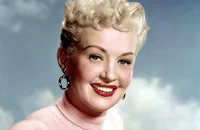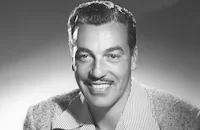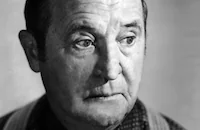Springtime in the Rockies

Brief Synopsis
Cast & Crew
Irving Cummings
Betty Grable
Carmen Miranda
John Payne
Cesar Romero
Charlotte Greenwood
Film Details
Technical Specs

Synopsis
During the thirty-fourth week of their hit Broadway show, dancer Vicky Lane awaits the arrival of her partner, Dan Christy, but as usual, he is late. Vicky thinks that Dan is buying her an engagement ring and is infuriated to discover that he has been on a date with socialite Marilyn Crothers. Fed up with Dan's womanizing and insensitivity, Vicky quits the show and returns to her former dancing partner and beau, Victor Prince, who is still in love with her. Three months pass as Dan sinks into a depression and cannot find a backer for his new show. His agent, the Commissioner, tells him that businessmen Bickel and Brown will back his show, but only if he can get Vicky to return. Dan is pessimistic, for Vicky and Victor are beginning a new engagement with Harry James and His Music Makers at a Lake Louise resort in the Canadian Rockies. The Commissioner tells Dan to romance Vicky so that she will come back, and not tell her about Bickel and Brown until she arrives in New York. He then asks bartender McTavish to get the drunken Dan on the next plane to Lake Louise. When Dan awakens sometime later, he finds himself at the Canadian resort and learns that he has hired McTavish as his valet and Rosita Murphy, who was working in a Detroit souvenir shop, as his secretary. He then confronts Vicky, who happily shows off the engagement ring given to her by Victor. Dan is discouraged but hits upon the scheme of making Vicky jealous by romancing Rosita. His plan appears to be working until Vicky learns the truth from Rosita, who has aroused the interest of Victor, although she prefers McTavish. Vicky's friend, Phoebe Gray, is also intrigued by McTavish, and the couples spend much time pursuing and arguing with each other. One evening, Dan barges into Vicky's room and refuses to leave when she summons Victor. Angered by Dan's presence, Victor accuses Vicky of being unfaithful, and she breaks off their engagement. Later that evening, Vicky and Dan reconcile, and he promises to be honest with her. He tries to tell her about the new show, but she rushes off to plan their departure the next morning. As she is checking out in the morning, Vicky runs into the Commissioner, and Bickel and Brown, who have just arrived and spill the beans about the show. Thinking that Dan is using her once again, Vicky runs off in tears, but the quick-thinking Rosita is able to cover up for Dan and convince Vicky that he intended to take her to California for their honeymoon. In the process, however, Bickel and Brown are lost as sponsors and Rosita must persuade McTavish to invest some of his inheritance into Vicky and Dan's new show. That accomplished, the show opens with Vicky and Dan as the star performers, supported by Harry James, Rosita and Victor, and McTavish and Phoebe.

Director
Irving Cummings
Cast

Betty Grable

Carmen Miranda

John Payne

Cesar Romero

Charlotte Greenwood

Edward Everett Horton
Harry James
The Banda Da Lua

Frank Orth
Harry Hayden

Jackie Gleason
James Mcafee
Helen Forrest
Six Hits And A Miss
Trudy Marshall
Roseanne Murray
Billy Wayne
Chick Chandler
Patrick O'moore
Anthony Marsh
Bill Mcguire
Iron Eyes Cody
J. W. Cody
Bill Hazlett
Claire James
Dick Elliott

Bess Flowers
John Coffey
Pearlie May Norton
Emmett O'brien
John Mcavoy
Perk Lazelle
Warren Crosby
Walton Walker
Valerie Traxler
Sol Haines
Joe Hickey
Kay Adell
William Bessire
Dorothy Warren
Meredyth Durrell
George Lloyd
Bill Benter
Roy Damron
Gloria Gale
John Roche
Jeanne Francis
Harvey Karels
Bob Crosby
Dona Massin
Loretta Barnett
Bud Lawler
Paul Foltz
Jewel Mcgowan
Ruth Riley
Marcia Sweet
Jack Barnett
Janet Graves
Mary Stewart
Eleanor Bayley
Grace Davies
Marjorie Raymond
Bob Milton
Bud Carpenter
Ralph Hubbard
Eddie Searles
Dorian Johnston
Margo Woode
Lola Cogan
Crew
Count Basie
Walter Bullock
Eric Coates
Richard Day
Ken Englund
William Goetz
Mack Gordon
Stella Harris
Roger Heman
Henri Jaffa
Harry James
Natalie Kalmus
Arthur Von Kirbach
William Koenig
William Lebaron
Thomas Little
Earl Luick
James V. Monaco
Alfred Newman
Aloysio Oliveira
Ernest Palmer
Hermes Pan
Guy Pearce
Alberto Pestalozza
Gray Rains
Robert Simpson
Gilbert Souto
Jacques Thery
Alcyr Pires Vermelho
Harry Warren
Joseph C. Wright
Saul Wurtzel

Videos
Movie Clip



Hosted Intro
Film Details
Technical Specs

Quotes
Trivia
Notes
Although Philip Wylie's story was published under the title "Second Honeymoon," it was purchased by Twentieth Century-Fox under the title "Worship the Sun." A Hollywood Reporter news item noted that Frederick Jackson was working on the picture's script, but the extent of his contribution to the completed film has not been confirmed. According to a December 20, 1941 story outline, contained in the Twentieth Century-Fox Produced Scripts Collection at the UCLA Arts-Special Collections Library, Fred Astaire and Rudy Vallee were originally considered for the male leads. According to the the Records of the Legal Department, also at UCLA, the studio paid $1,000 for a waiver from Villa Moret, Inc, the copyright proprietors of the song "When It's Springtime in the Rockies," so that there would be no legal conflict using the title Springtime in the Rockies. The legal records also reveal that Twentieth Century-Fox paid approximately $1,160 to Republic Pictures, which had prior claim on the title for use on a Roy Rogers picture. That film was then released as Romance on the Range in 1942. A June 22, 1942 studio press release noted that the songs "Magazines" and "I Like to Be Loved By You," written by Mack Gordon and Harry Warren, were to be included in the film, although they were not included in the finished picture. According to a Hollywood Reporter news item, the studio intended to shoot the picture on location at Lake Louise in Canada due to "defense regulations hindering exterior shooting in the Hollywood area." Only background shots were filmed in Canada, however. "I Had the Craziest Dream," which is sung by Harry James's band singer Helen Forrest in the film, became one of Betty Grable's signature songs. Grable and James were married in 1943, and according to modern sources, they named their first-born daughter, Victoria Elizabeth, after the character Grable played in this film. The couple were divorced in 1965. Grable starred with Dick Powell in the Lux Radio Theatre version of the film, which was broadcast on May 22, 1944. Twentieth Century-Fox first filmed Wylie's story in 1936 under the title Second Honeymoon. That picture was directed by Walter Lang and starred Tyrone Power and Loretta Young (see AFI Catalog of Feature Films, 1931-40; F3.3939). The legal records reveal that in 1946, the studio intended to film another remake, entitled Autumn in Acapulco, but that version was never produced.

Miscellaneous Notes
Released in United States 1942
Released in United States April 1981
Released in United States on Video May 25, 1989
Released in United States 1942
Released in United States April 1981 (Shown at FILMEX: Los Angeles International Film Exposition April 2-23, 1981.)
Released in United States on Video May 25, 1989












